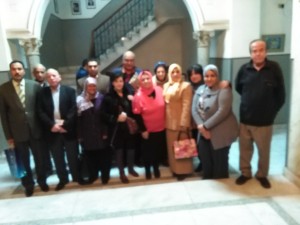Al-Ahram Weekly 6 - 12 August 1998
The Tent - novel by Miral el-Tahawy
Reviewed by Nur Elmessiri
Voices from Miral Al-Tahawy's The Tent:
"A house without a man is like an oasis without a well, a wasteland. Only a tent peg keeps a tent up, and a tent peg needs ground to hold it. A good woman will provide you with fertile pasture, my son" (Grandmother Hakima).
"They left him an old female falcon which they said had fallen into their baggage. They hammered a peg into the ground for her in front of the tent and she went round in circles at the end of the tether. When Zahwa came out she saw that her eyelids had been stitched closed and her wings trussed up her back... I reached forward. I just wanted to pull out the stitches from her eyelids and look at her eyes, but Zahwa pulled back my hand. 'If she sees the sky she'll go mad. Leave her,' she said" (Fatima).
"To my body... a tent peg crucified in the wilderness" (author's dedication).
The Tent, Al-Tahawy's first novel, first appeared in Arabic in 1996 and was received favorably by critics. Translated into English by Anthony Calderbank, it has been published this year by AUC Press in its Modern Arabic Writing series.
"Beautifully written," the book jacket tells us, and, indeed, the poetic quality of the original comes across splendidly in translation. In fact, the translation also has an advantage over the Arabic original -- clear, useful punctuation, to which one wonders why copy editors of Arabic books often pay scanty attention.
The summary on the jacket is useful not only because it highlights some of the novel's themes. A summary, once it is on the jacket of a book which is up for sale (and for review), is never innocent. It is an important component of the packaging process which transforms a literary text into a commodity, a manuscript into a book that figures in a literary market. Key phrases in the summary on the jacket of this English edition of The Tent are: "a host of women characters whose lives are subject to the will of a single, often absent patriarch"; "the lives of the Bedouin and peasant women unfold"; "the tragedy of the sonless mother"; "a foreign woman who is well-meaning but ultimately motivated by self-interest"; "an intimate glimpse inside the women's quarters." (Mis)readings are often telling, and the jacket summary's (mis)reading of The Tent tells the reader interested in the material context of book production something about the Arabic literature in translation market.
The Tent is jam-packed with women characters, mostly Bedouin, but the novel does not problematise or enrich the vague, semi-exotic notions one may already have about "the life of Bedouin (or peasant) women". In the novel Bedouin Woman roams the desert (unless she is an upper class Bedouin), Gypsy Woman is independent, and Peasant Woman does not really figure much.
Which is not to say that a novel has to be "social realist" -- and "social realist" this one is not. Its "host of women characters" are types one may have met before in narratives of oppressed Arab women or in tales from the Oriental harem. They are: Fatima, the protagonist narrator who deals with her sense of isolation, confinement, alienation and helplessness by living in a fantasy world and by climbing trees and hiding in wells in order to see beyond the walls of her father's house, and pays the price of such attempts by eventually becoming a "demented cripple"; Fatima's mother who miscarries sons; tyrannical paternal grandmother Hakima who spends her time cursing her grand-daughters, advising her son to "get rid of" them, through marriage, though rumour has it that none of her daughters survived because she strangled them; Fatima's three older sisters: Safiya, the maternal, and Fouza and Rihana who embroider all day; Sardouba, the kind slave in whose lap Fatima seeks regular solace; Sassa, the other slave; Mouha the gypsy; Ann, the foreigner; women in Fatima's fantasy world: Sigeema the Bedouin who has more freedom of mobility than do the women in Fatima's "real" world and her daughter Zahwa, Fatima's doppelganger; Fatima's two successive step-mothers: Dawabba, the cruel and Rahaat, the kind; Fatima's half-sister Samawat who replaces Fatima in her father's heart...
That makes 15 women in the tight space of 130 pages. The reader is thus plunged into the stifling harem context which the protagonist, at the cost of her sanity, has to endure. By the end of the novel, even kind, maternal Sardoub becomes suffocating. The fact that Samawat's daughters, who make a brief appearance in the last few pages, are not subjugated to the same claustrophobic, mostly women space provides little consolation. For Fatima, and for the reader occupying Fatima's first person zone of consciousness, there is no outside to the house of the taciturn, mysterious, rather poetic Bedouin lord, the gates of which are firmly sealed. Women can only pass through the gates as "merchandise" from father to husband to labour at producing sons. The reader can only escape from this fairy tale castle on the wings of Fatima's survival strategy (pace Scheherezade) flights of fantasy -- lyrical, densely symbolic stories which act as a narrative counterpoint to the grim goings-on in the harem quarters. Though set against an open desert and sky backdrop, these stories, however, simply mirror the themes of the frame story with uncanny simplicity. In spite of the fantastical poetic topoi of the novel in which symbols bloom or wither, fly or crawl, gush water or bleed, the reader is ultimately held hostage to a claustrophobic, ahistorical space similar to that which Fatima and the other rich kept women of the novel are forced, by custom, to inhabit.
Though The Tent does not lend itself to being discussed primarily in terms of "plot", useful though this may be for a jacket summary, Fatima's relationship with her father could be taken as the novel's point of focus. Fatima loves her soft-spoken, traveler of a father; he is, after all, kind to her and takes her a bit more seriously than the others do. He is less macho, more sympathetically portrayed by Al-Tahawy than the jacket summary makes him out to be. But, still, Al-Tahawy's father figure does not flagrantly transgress certain representational norms. His use of what might be considered demeaning patriarchal/orientalist terms like "my princess", "my gazelle", "my pure Arabian filly" to express his love for his daughter places him firmly in the camp of Arab Patriarchs which the jacket summary evokes.
And Mother Figures? Archetypal, Sonless Mother in Patriarchal Society (allegorised not just in Fatima's mother, but also in Sigeema and the Queen in one of the folk tales) is more central to the novel than the specific "sonless mother" of Fatima. So, the emotionally loaded term "tragedy" used in the jacket summary does not really apply to The Tent. Tragedy presupposes three-dimensional characters with whom you can sympathise, development, conflict and so on. All we know about Fatima's pale mother, all Fatima herself knows about her, is that she sobs all day in her dark room, probably because of all the miscarriages she has had. Hardly material for "tragedy". Neither, grow fond of her though we do, is Fatima. A psychic condition which goes from bad to worse and, finally, to worst simply cannot be plotted against the tragic curve.
Women, Bedouin, sonless and oppressed, a patriarch -- and a Western woman. If the jacket summary did not spotlight her, a less "sophisticated" reader, while obviously noticing Ann's strange presence in the novel, would have placed her on equal formal footing as, say, Mouha the gypsy and may well have asked: "Just what is this unlikely, anomalous foreigner doing in a tale of cloistered Bedouin women?" An "academic" reader, however, would quickly recognise that, though her appearance in the novel is quite brief, Ann is being used to make a (by now perhaps trite) point, namely: though power is gendered (men tend to have more power to make life-affecting decisions than do women, especially in "traditional societies"), nonetheless, "male" is a social construct, and women can occupy a subjugative "male" position vis-à-vis other women. Hakima with her prodding cane and Ann are such women -- except that Ann is also a Westerner, an "Orientalist" who educates a native because she wants her horse and also so that she can amuse her with exotic folk tales and songs, a Westerner whose knowledge of modern health practices leads to Fatima's (already gangrenous) leg being amputated. The jacket summary packaging of the novel simply mirrors what a post-colonial/feminist reading of The Tent would, inevitably, do: it zooms in on Ann, even if Ann is as insubstantial a shade in Fatima's sensitive, fragile psyche as are the other characters, even if Fatima is already pretty well oppressed, marginalised and schizophrenic long before Ann comes into the picture.
There is something in this novel for everyone -- even for the incorrigible Orientalist Western male who might voyeuristically want the "intimate glimpse inside the women's quarters" which the jacket promises. For the "average" reader who does not want to be taxed with a high dose of complexity or ambiguity, there are beautiful images, a myriad of lovely tales and symbols that do not overwhelm by their density. A reader who would be put off by the kind of novel that goes down well with a "politically correct" audience while at the same time retaining a veneer of exotica to appeal to the Orientalist in us all, would do well not to heed the signs on the jacket summary of this edition of The Tent. Instead of heeding them, the reader can go straight from the jacket cover, beautifully illustrated by Hoda Lutfi, to the elegantly translated "thing itself".




